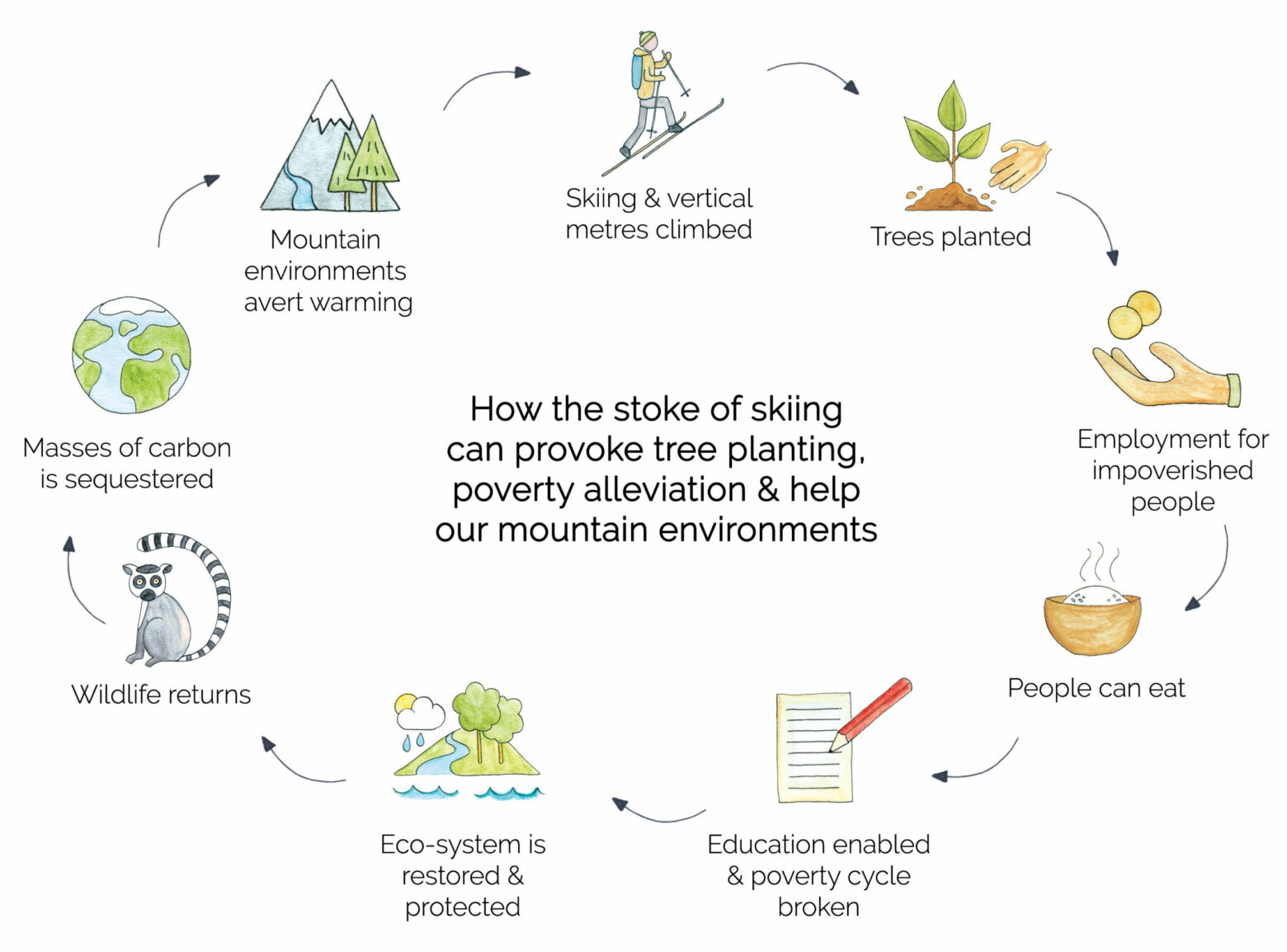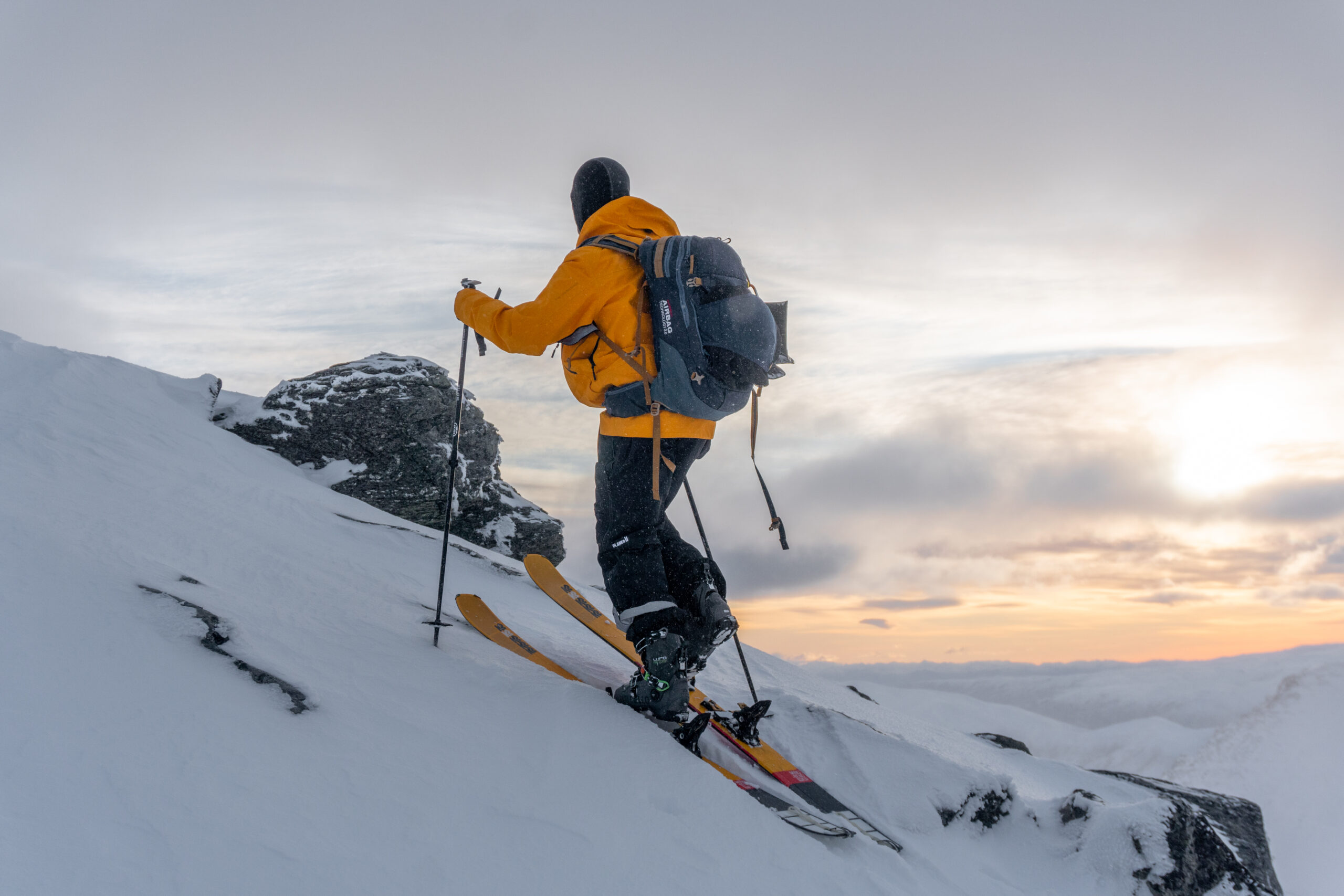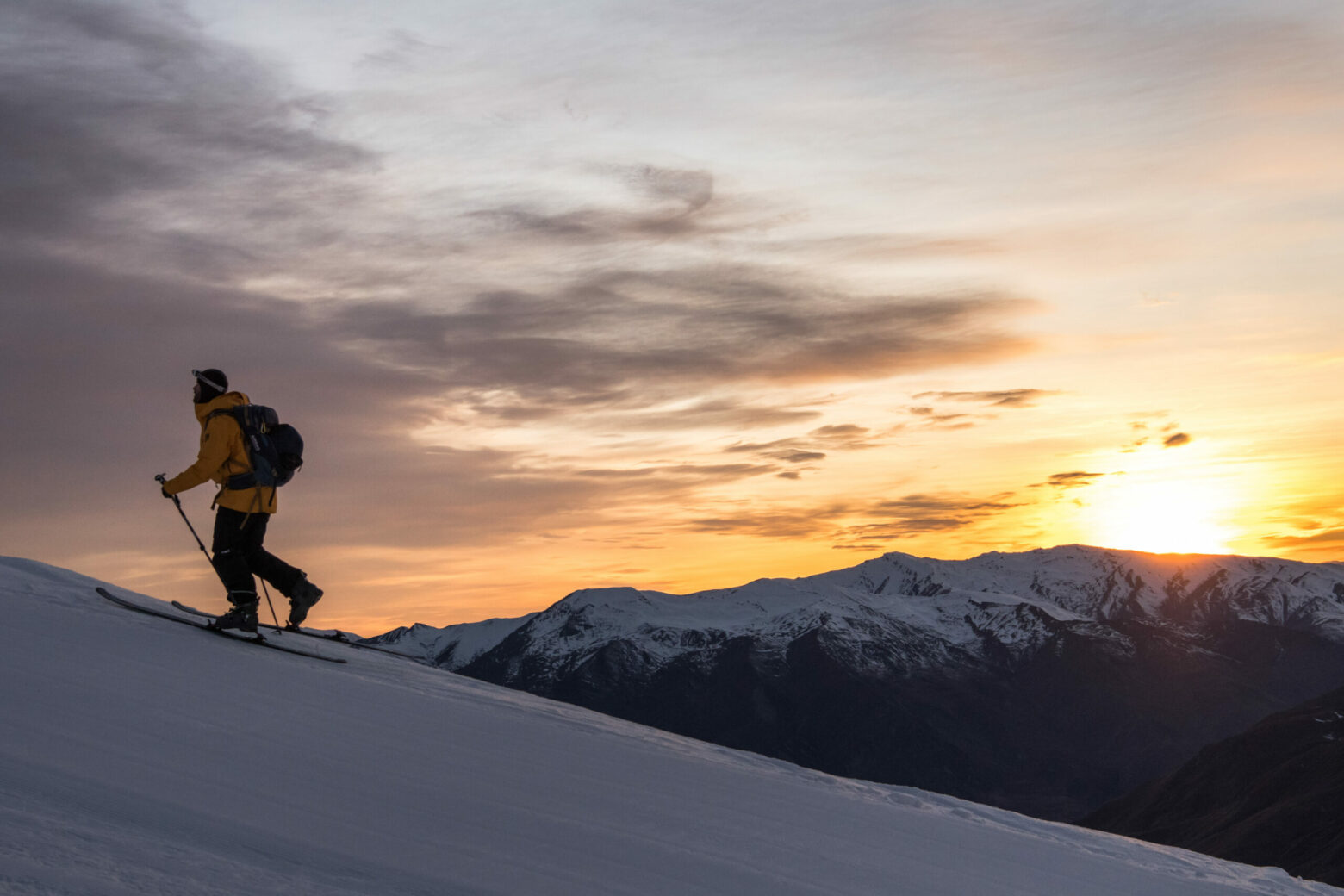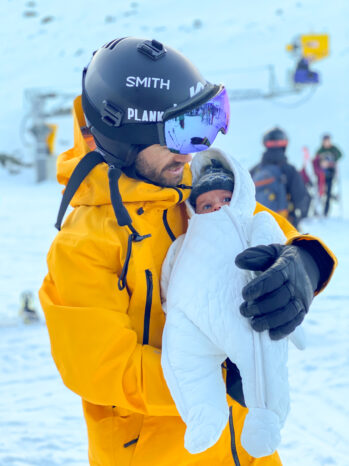This website uses cookies to ensure you get the best experience on our website. To read our full cookie policy please click here.
Pete Oswald: The ups and downs of Ski for Trees
Man on a mission
New Zealand-born freeskier and photographer Pete Oswald has planted over 126,000 trees (May 2021) through his unique Ski for Trees project.
Planting 1 tree for every 1 vertical metre climbed, Pete channels his passion for ski and the mountains with his awe-inspiring drive to do good for people and planet.
Here Pete tells us, in his own words, about the challenges he faces, balancing family life and why focusing on Madagascar in so beneficial on both a global and local level.
Words by Pete Oswald, images by Sean Beale & Pete Oswald.
“In May 2020 I presented an ambitious idea to a crowd of about 300 enthusiastic Queenstown based ski tourers.
That idea was to plant 20,000 trees by climbing 20,000 vertical metres in the pursuit of skiing.
By the end of the 2020 New Zealand winter Ski for Trees, and the projects’ generous donators, had funded the planting of over 100,000 native trees towards permanent reforestation in Madagascar where they are desperately needed – 5 times the initial goal, creating over 1000 fair wage employment days which has helped to save lives and break the poverty cycle that drives the deforestation.
So to achieve this I just setup a donation page, went skiing, and triumphantly posted on social media about saving the world whilst righteously dodging my responsibilities as a new parent, right…?
If only that was how it went…..
Upon presenting my idea back in May 2020 the crowd of scroggin munchers stared back at me with 300 blank faces.
The silence of their zero response between me making each point was disturbing.
It was 9.30pm and the outdoors focused scroggers had been sat inside listening to various speakers of varying entertainment levels since 6.30pm, of which I was the last. This restless crowd appeared drained.
However, when I explained my way around a circular flow diagram demonstrating how planting trees “over there” helps our glaciers, snowfall and future of shredding “here”, a murmur started which amplified into a cheer – the idea appeared to resonate and have legs.
I first had this idea 5 months earlier in January 2020. Then COVID hit, lockdown happened and apparently the financial fallout would see our societies very survival threatened… or brawling in Pac N Save over toilet paper as it turns out. So the idea was suppressed until it was clear that NZ society was going to stay largely intact and someone was still producing enough paper with which we could all wipe our bums – which was about early May.
By then the idea had crept back into my head as something that I had the power to do… and should do. My wife Sophie and I were not new to charitable tree planting – our business, Little Difference partnered with Eden Reforestation Projects plant one tree for every single product sold, and had just surpassed 100,000 trees.
We had been to planting sites in Madagascar to see the effect of the tree planting for ourselves and we were blown away by the environmental and social impact of even a small investment. So, I had the infrastructure, connections and confidence of the plan in place, as well as a bit of an audience. I was sitting on an idea to help people and planet and in a unique position to make it work. I felt if I didn’t sack up and give it a crack then I would forever feel like a dreamer, rather than a doer.

So I presented my idea to the bored and hungry scroggin munching ski tourers – the audience seemed to like it, I said I would do it – so I was committed.
But will people part with their cash I wondered? The original plan was to get donations from my connections to the ski and outdoor industry businesses but the business sector in early COVID times turned out to be tighter than a downhill racers din settings, apart from a couple of anomalies like Sportive NZ Distribution, Small Planet Sports and Ecoski.co.uk.
So to the general public I focused my plundering for the plantations. But with our business, Little Difference, customers actually got a physical product as well as a tree planted.
With Ski for Trees I was relying on donators being content with only receiving warm fuzzies for helping people they will never meet and plant trees in a place they will probably never visit. Would it work?
At the end of that presentation in May I had collected contact email addresses from people I identified as potential donators and who expressed interest.
This, as well as pressuring my good friends and family to donate as a personal favour to me, I had a starting point on which to try to build momentum.



The Ski for Trees concept was 1 metre climbed = 1 tree planted, so I needed some vert under my belt to inspire people to give.
From early winter the day usually went like this… my alarm sounded at 5.15am, I lit the fire in our tiny house to get it cosy for Soph and Tula, if Tula was awake I would take her downstairs to change her nappy and then Tula and I would make tea and breakfast for Soph.
Then I was out the door by 5.50am (ish) with all my gear that I had usually prepped the night before.
At the time our tiny house was located right at the bottom of the Coronet Peak access road and early morning touring up the peak is a popular thing, some mornings there would be thirty cars parked at the base building of just keen scroggin munchers.
So to get up the access road I would either catch a ride with other keen mates, pick people up, hitch hike, wave down the Coronet Peak staff van or, on a few occasions, I biked from home with my skis, boots and poles on my back. I avoided driving our car solo up the mountain as much as possible.

Queenstown, NZ
This was an environmentally focused project, it’s not a great look to lazily fly solo up the hill in our gas-guzzler and I was aware of the possibility of getting called out which could threaten the success of the project. Plus I wanted to set an example. But, some mornings there were just no keen beans to go with and biking up 800 vertical metres in the dark with skis on my back before starting to ski tour up the resort is hard, so yeah I admit, on the odd occasion I bloody well drove solo.
Anyway, I tried to make my way to the base of the resort in the most ethical way I could. Once up there I thought I may as well get all the vert I could, one lap up is about 450 vertical metres so I would often do a second lap to the top. Sometimes when I had another frothing scrog dog with me and the conditions were good we would tour to the top of the resort then out the back to do a few laps harvesting fresh pow lines in the slack country.
There was usually no shortage of frothing scrog dog ski tourers to persuade, sometimes there were even fresh scrog converts who came for their first ever day touring on one of those mornings after seeing my onslaught of social media posts.
Sharing their stoke and the splendour of early morning alpine sunrises fed my froth even more. Once the metres were climbed and the froth subsided I could usually be back at the tiny house to resume work and/or parental duties by 9.30am.

The Remarkables, NZ
Of course we often went skiing as a family too. By the time Tula was 3 months old she had come up more days skiing than weeks she had been alive. These days we normally went to the The Remarkables and we had a system. Tula usually woke at about 5 am so rather snoozing back to sleep we just got up, got ready and went skiing – what ever the weather.
Quite often we were the very first car up there, we got settled at our usual table in the café and I completed a climbing lap to the top of the resort gaining vertical metres before the lifts even started to turn. Upon my return Soph and I did a switch-a-roo, daddy looked after Tula and Soph lined up for first lift before 9am. I often got a few extra bonus metres later in the day by hiking ‘the chutes’ or other hike access lines that looked ripe for ripping – if I’m going to climb something in the name of trees then I may as well climb something worth shredding.
The 2020 ski season lacked multi-day adventures such as an ascent and ski descent of Aoraki/Mt Cook that 3 friends and I had done just the previous spring. But Soph and I were new parents and we were learning on the job, routine was important to attempt but seldom achieved. Nonetheless it was a team effort and I needed to be around.
“I often got a few extra bonus metres later in the day by hiking ‘the chutes’ or other hike access lines that looked ripe for ripping.
If I’m going to climb something in the name of trees then I may as well climb something worth shredding.”

Coronet Peak, New Zealand
As new parents, though, we managed to get a lot of skiing done, but one thing was very apparent; Ski for Trees was in no way possible without Soph. The project took a lot of my time but also put more pressure on Sophie as a mum. Any new mum knows the immense struggles they face that the rest us will never properly be able to appreciate. It takes a certain type of mum of a newborn baby who, while living in an unfinished tiny house with uncertain and limited financial circumstances of a new business in the fallout of a global pandemic, would be willing to take on the extra stresses of a disconnected idea of raising money for people and planet a world away. But Soph did just that.
I was well aware Ski for Trees would demand a considerable time commitment from us as new parents in order to make it work but one thing I dramatically under estimated was the digital grind of a fund raising project. Climbing 30,000 vertical metres over several months accumulates to many hours of time investment. Don’t get me wrong; I loved this part of it, and every metre suffered climbing up got to be savoured whilst shredding back down. But, for every hour I spent in the hills accumulating metres I spent two hours bound to a screen grinding out digital information. It wasn’t a case of setting it up and letting the donations roll in. In order to convince people of the purpose it was a relentless and repetitive daily process of recording, publishing, researching, updating, processing imagery and communicating.
Most of that admin stuff I had prepared to do and part of it, like recording the accumulation of metres climbed and trees planted, was motivating. But a lot of the digital workload, which I had not really considered, was giving assurance to donators. With charitable fund raising comes scrutiny and scepticism. People want to know that what I’m saying is happening – is actually happening, that the trees are being planted and they want to know I’m not taking a cut of their generosity. So, displaying data, providing transparency, asserting assurance and validating the tree planting became much of my digital grind routine.

Madagascar
And there was one question that was always asked. “Where are the trees planted?”
My answer is “Madagascar”, you know that massive African island?
Then they’re like “yeah from the self-titled animated movie, why there? Why not plant them here in Aotearoa?” Some other people would say “I would rather support a tree planting project in New Zealand”.
Then I would ask them why they would rather plant trees in NZ. This was often met with surprise and a blank face. I get it though, this is our home, we want to plant native trees here to help our local eco-systems, increase habitat for our endangered wildlife and make it look all nice and pretty to be true to our global reputation as clean and green.
Here’s the thing about Madagascar though. It is not covered in lush forest like the animated movie depicts or what the imagery from wildlife docos suggests. 90% of all the forest has been destroyed. What remains are loosely protected tiny isolated pockets of forests left to support the most diverse population of endemic life, 75% of Madagascan plant and wildlife species are not found anywhere else in the world and many of these are quickly becoming extinct.
The deforestation leaves a vast landscape of desertification – with the forest gone rainfall decreases, with no vegetation to bind and hold the fertile soil, any rain that does fall washes the top soil to the ocean leaving the land to turn to desert and destroying ecosystems in the shallow seas. Both land and sea are then far less productive as a food source for the human population. This drives poverty of the local Malagasy people, which drives desperate and destructive farming methods like slash and burn which further fuels the deforestation.
Jamie Shattenberg the director of the reforestation in Madagascar helped me put myself in their shoes. If there is one tree left standing in my village and cutting that last tree down means my baby daughter, Tula, will survive another day. That tree does not stand a chance.
Employing the poorest and most impoverished of the local population to replant and protect their forests puts this process in reverse.
Many of us also want to plant trees in order to sequester carbon dioxide to reduce global warming to avoid a massive range of global problems, and as privileged skiers, snowboarders and mountain lovers one of these reasons is to save our glaciers and curb the decline of annual snowfall.
The Tasman Glacier in Aoraki National Park doesn’t care where you plant trees and sequester that CO2 from, just like CO2 emissions are not patriotic to the country they are emitted from, they make their merry way around the whole globe warming everything up. The Tasman Glacier cares that we pull those gases down (from anywhere in the world) to restore environmental balance that will stop the Earth warming – the whole Earth.

Mahajunga, Madagascar
To plant a native tree in Aotearoa costs about $10, and often a bit more than that to ensure it survives. $10 USD donated with Ski for Trees plants at least 100 native trees towards permanent reforestation in Madagascar, which are protected to maturity.
Neither method is right or wrong, both have many unique benefits, I am simply challenging our sometimes blind New Zealand patriotism. I don’t have any credentials to preach this by the way, I can only put together what I have researched and what I have seen and this is what I can say.
The Ski for Trees project of the 2020 New Zealand winter planted just over 100,000 trees. Those 100,000 trees sequester and average of 1,230 tonnes of CO2 per year, enough to offset 160 kiwis CO2 emissions… every year for the life of those trees.
100,000 trees is a forest and if protected, which they are, the trees will self-seed, regenerate and expend. That forest will be there, self perpetuating and expanding, sequestering C02 and giving us oxygen for as long as we as humans will let it.
The funds donated by the generous Ski for Trees donators provided over 1,000 days of fair wage employment to local Malagasy people who were previously stuck in systemic, intergenerational poverty.
The social aspect is something we did not fully understand or appreciate properly until going to Madagascar and seeing it for ourselves. The employees who plant these trees, who before struggled to feed themselves and their family, can now plan past trying to find the next meal.
They can nourish their family, get access to medicine, adequate shelter and clean water. They can get education for them and their children. Their focus shifts from survival today to prosperity and a better life for them and their children in the future. These people, who were once the source of destruction of the forest, are now the ones regenerating and protecting it. The shackles of systemic intergenerational poverty are broken.
These people know the value of these forests because they are aware that their well being as well as their children’s future depend on it – a concept that we in the developed world have distanced ourselves from.
Perhaps the people who asked “so where are the trees planted?” weren’t always prepared for the detailed response they got, but it seemed to make sense to most. These were the ideas I was pushing, posting and publishing while climbing metres each day. The concept was 1 metre climbed = 1 tree planted, climbing many metres was how I grab peoples attention.

Queenstown, NZ
However, on the 19th September 2020, on the same day as climbing my 30,000th metre I under rotated a back flip and tore my calf muscle. I thought this could threaten the potential of the tree planting.
But the seed was sown, the idea had germinated and the momentum provided by the metres already climbed was perpetuating.
No more metres were needed; I just needed to spread this idea into numerous more fertile minds.
So with my injured leg elevated I set about as a tree-hugging keyboard warrior – social posting, writing newsletters and pestering anyone I could think of who might resonate with this idea.
During the course of the project Ski for Trees was gradually published in the media on websites, newspapers, TV sport shows and the 6pm prime time Channel One News. When the founders of other tree planting fundraisers around the world reached out for information and told me Ski for Trees was their inspiration, I felt I was finally doing justice to the idea that I had committed to.
The point of the project was to use the privilege of skiing to make a positive environmental and social impact in developing countries where the privilege of skiing is a world away. I like the concept of acting together as a planet, not just a country.
David Attenborough says we need to lift up our most vulnerable of the world in order to make the environmental changes we need. As citizens of developed nations should we be looking more to developing nations to progress our collective environment as a planet?
During this project a friend of mine pointed me to this quote by Hyacinthe Loyson, which I think says it best –
“Plant trees under whose shade you may never sit”.
Thank you so much to the past present and future supporters of Ski for Trees.”
Find more information about Pete Oswald and Ski for Trees here:
www.peteoswald.co.nz/ski-for-trees
Pete has a fresh concept for Ski for Trees for this coming 2021 New Zealand winter, see the link above find out more and to receive updates.
Ski for Trees donations be made here, 100% of which goes directly to planting trees in Madagascar.
With thanks to Pete Oswald for words and thanks to Sean Beale & Pete Oswald for allowing us to use their images.

